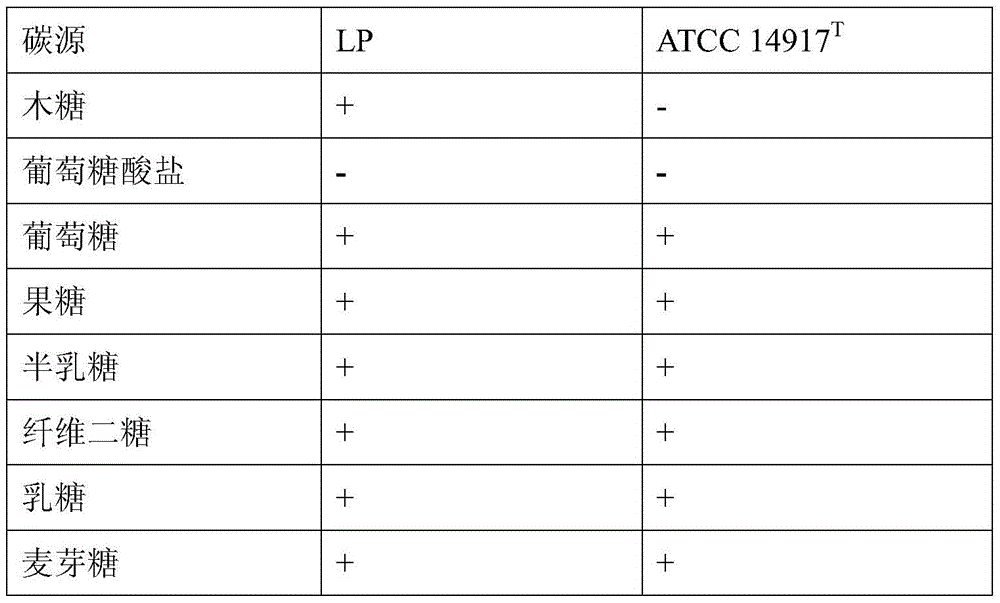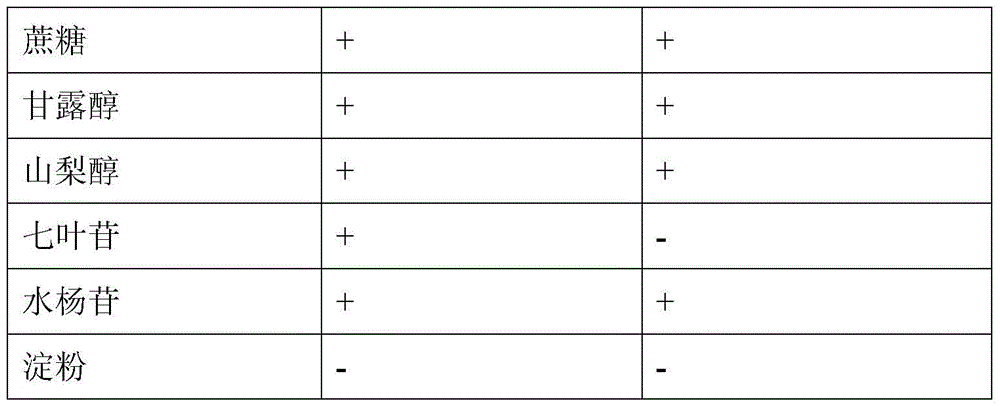Plant lactobacillus and application thereof in ensilage of warm-season forage
A kind of Lactobacillus plantarum, warm-season technology, applied to Lactobacillus plantarum and its application field in warm-season pasture silage, can solve the problem of no biological additives and the like, achieve no environmental pollution, increase lactic acid content, and improve fermentation quality Effect
- Summary
- Abstract
- Description
- Claims
- Application Information
AI Technical Summary
Problems solved by technology
Method used
Image
Examples
Embodiment 1
[0027] Example 1: Isolation and Identification of Lactobacillus plantarum LP1
[0028] Take 20g of natural wild grass silage in Hebei area, add 180mL of distilled water, shake it with a shaker for 30min, 10 -1 -10 -6 Gradient dilution. Take 1mL from each gradient dilution solution into a petri dish, add 10-15mL sterilized MRS solid medium, shake well, wait for it to cool and solidify, let it stand for anaerobic culture for 48h, pick the colony shape, size, For single colonies with obvious differences in color and gloss, streak repeatedly until pure colonies are obtained.
[0029] The isolated and screened strains were identified and analyzed comprehensively based on their cell morphology, physiological and biochemical characteristics, and 16SrDNA gene sequence. The strain was identified as Lactobacillus plantarum and named LP1, which is a new strain of Lactobacillus plantarum.
[0030] The biological characteristics of the strain LP1 are as follows: the LP1 strain grows wel...
Embodiment 2
[0036] Embodiment 2: Growth assay of plant lactobacillus (Lactobacillus plantarum) LP1 under different pH, temperature and salt concentration environmental conditions
[0037] Use 1mol / L hydrochloric acid and 1mol / L sodium hydroxide to adjust the initial pH value of the MRS medium to 3.0, 3.5, 4.0, 5.0, 6.0, 7.0, 8.0, 9.0 respectively, and cultivate plant milk at a constant temperature of 37°C Rod LP124h, without acid adjustment during the cultivation process, the light absorption value at 600nm (OD600) was measured with a spectrophotometer, and the results are shown in Table 2. The results showed that Lactobacillus plantarum LP1 could grow under the condition of initial pH3.5-pH8.0.
[0038] The activated Lactobacillus plantarum LP1 was inoculated in the MRS liquid medium, cultured at 10°C, 15°C, 20°C, 30°C, 40°C and 45°C for 24 hours, and the light absorption at 600nm was measured with a spectrophotometer Value (OD600), the results are shown in Table 2. The results show th...
Embodiment 3
[0044] Embodiment 3: Plant Lactobacillus (Lactobacillus plantarum) LP1 and cellulase are used as biological additives to prepare warm-season grass silage
[0045] 1. Raw material preparation:
[0046] (1) Forage preparation: Taking elephant grass (Pennisetum purpureum Schum.) and multi-flowered ryegrass (Lolium multiflorum Lam.) as examples, the pasture is mowed from the jointing stage to the earing stage to ensure that the raw materials are clean and free of impurities such as soil and manure. As short as 2-3cm.
[0047](2) Preparation of biological additives: Lactobacillus plantarum LP1 and cellulase were activated by adding water (without disinfectant) for 20 minutes.
[0048] 2. Preparation of warm-season forage silage
[0049] Spray the activated Lactobacillus plantarum LP1 and cellulase on the treated grass, and the amount of Lactobacillus plantarum LP1 added is not less than 10 9 CFU / kg fresh grass, cellulase not less than 100U / kg fresh grass, mix well and fill immed...
PUM
| Property | Measurement | Unit |
|---|---|---|
| Density | aaaaa | aaaaa |
Abstract
Description
Claims
Application Information
 Login to View More
Login to View More - R&D
- Intellectual Property
- Life Sciences
- Materials
- Tech Scout
- Unparalleled Data Quality
- Higher Quality Content
- 60% Fewer Hallucinations
Browse by: Latest US Patents, China's latest patents, Technical Efficacy Thesaurus, Application Domain, Technology Topic, Popular Technical Reports.
© 2025 PatSnap. All rights reserved.Legal|Privacy policy|Modern Slavery Act Transparency Statement|Sitemap|About US| Contact US: help@patsnap.com



